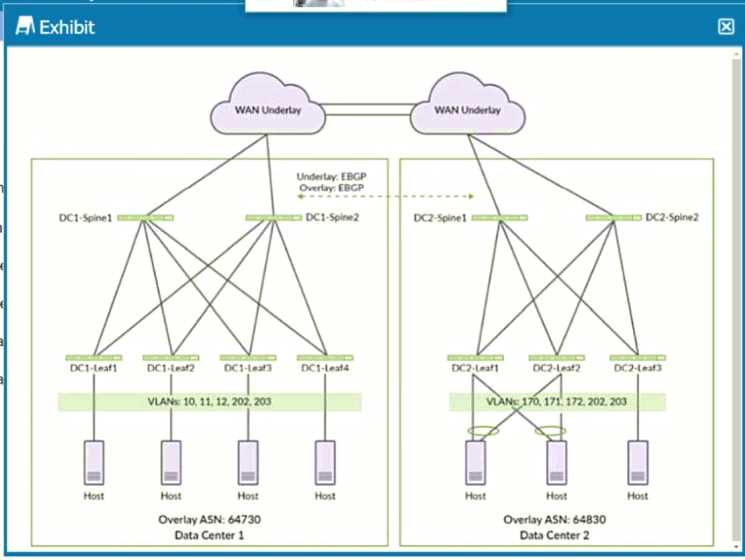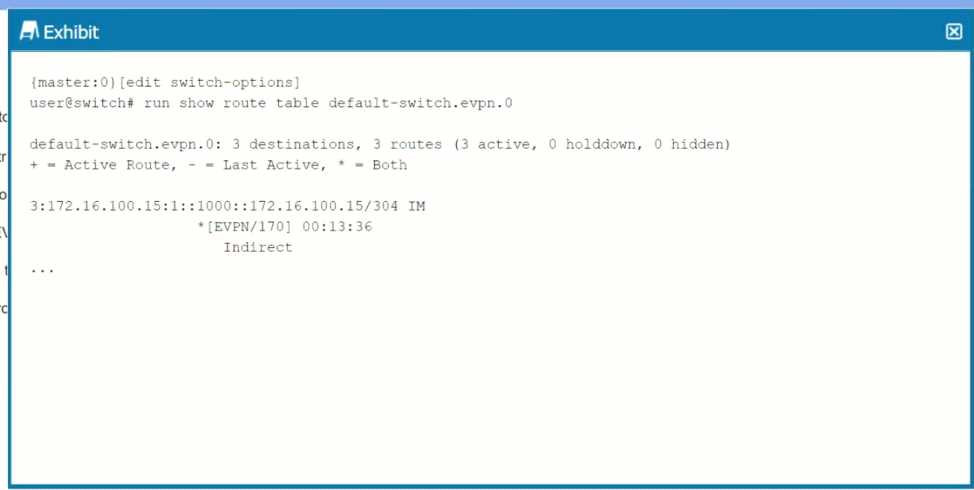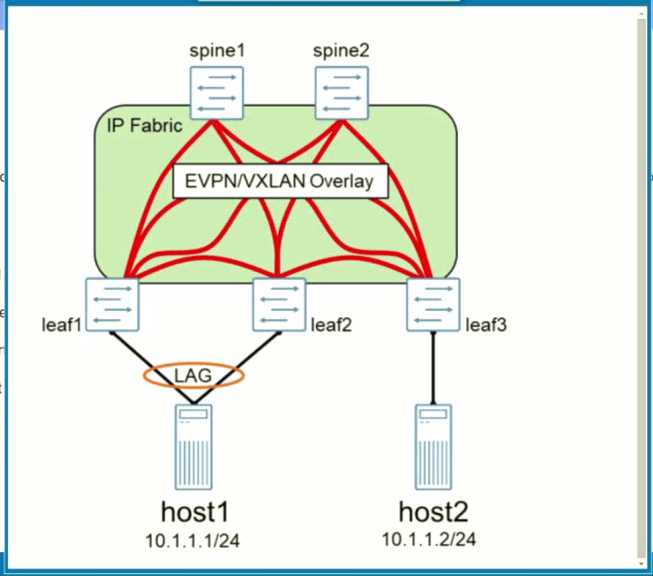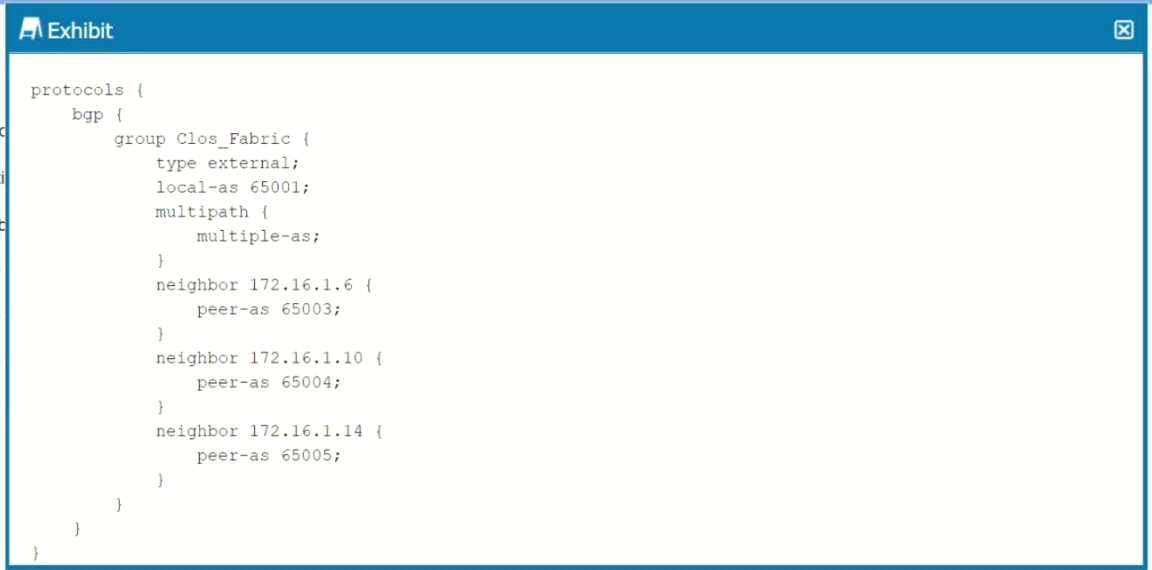Juniper JN0-682 Exam Questions
Questions for the JN0-682 were updated on : Dec 09 ,2025
Page 1 out of 5. Viewing questions 1-15 out of 65
Question 1
Exhibit.
The two data centers shown in the exhibit need to be connected using EVPN.
Which two statements are correct in this situation? (Choose two.)
- A. Hosts in VLAN 10 can communicate with hosts in Data Center 2 using Layer 3.
- B. Hosts in VLAN 10 can communicate with hosts in Data Center 2 using Layer 2.
- C. Hosts in VLAN 202 can communicate using Layer 3 between data centers.
- D. Hosts in VLAN 202 can communicate using Layer 2 between data centers.
Answer:
AD
Question 2
You are asked to deploy an Ethernet bridging design in a data center with the criteria shown below.
-- Routing must occur on the spine devices.
- VTEPs must terminate on the leaf devices.
- Facilitate inter-VLAN communication.
-- Layer 2 gateways must be present on spine and leaf devices.
Which architecture should you use in this scenario?
- A. edge-routed bridging architecture
- B. centrally-routed bridging architecture
- C. bridge overlay architecture
- D. collapsed spine architecture
Answer:
B
Question 3
Exhibit.
Referring to the exhibit, which statement is correct?
- A. Leaf1 has not learned any MAC addresses
- B. Leaf3 is the remote tunnel endpoint.
- C. One tunnel is servicing multiple VLANs
- D. Spanning Tree Protocol is disabled
Answer:
C
Question 4
Exhibit.
Which statement is true about the route shown in the exhibit?
- A. The route target on this route is 1000
- B. The route is an EVPN type-1 route.
- C. The route uses a type-1 route distinguisher.
- D. The VNI for this route is 304.
Answer:
D
Question 5
Exhibit.
An EVPN-signaled VXLAN overlay has been deployed in the network shown in the exhibit. An EVPN
LAG has been configured to connect host1 to the network, and device leaf1 has been elected as the
designated forwarder.
- A. The Ieaf3 device can utilize both leaf1 and Ieaf2 to forward unicast packets from host2 to host1.
- B. An ICCP control link must be configured between leaf1 and Ieaf2.
- C. The Ieaf3 device will only receive an advertisement to the LAG segment from leaf1.
- D. Broadcast packets sent from host2 will not be forwarded to Ieaf2.
Answer:
C
Question 6
You are asked to manage multicast traffic in the EVPN-VXLAN environment. You must ensure that
multicast traffic is delivered only to the leaf device with interested receivers. In this scenario, which
feature is required on leaf devices to accomplish this task?
- A. PIM
- B. IGMP snooping
- C. MSDP
- D. DVMRP
Answer:
B
Question 7
You are asked to configure JTI on the QFX Series devices in your data center fabric. You must use
sensors with the least amount of latency. Which type of sensor should you use in this scenario?
- A. Python sensors
- B. JTI native sensors
- C. analog sensors
- D. JTI OpenConfig sensors
Answer:
B
Question 8
You are configuring a DCI VPN solution between sites that require an L3VPN to work with your EVPN
deployment. Your organization's policy restricts configuring RSVP and LDP on your WAN links. While
configuring the solution, you notice that no routes exist in the inet table.
In this scenario, which parameter will solve this problem?
- A. bgp family inet labeled-unicast per-group-label
- B. bgp family inet labeled-unicast aggregate-label
- C. bgp family inet labeled-unicast resolve-vpn
- D. bgp family evpn signaling
Answer:
D
Question 9
Exhibit.
You are troubleshooting a traditional Clos Layer 3 IP fabric in your data center. You are reviewing the
BGP configuration for one of your spine devices.
Referring to the exhibit, which statement is correct?
- A. This spine device will not install multiple next hops for remote destinations in its routing table.
- B. This spine device will not install any routes for remote destinations in its routing table.
- C. This spine device has three neighboring leaf devices.
- D. This spine device has three neighboring spine devices.
Answer:
C
Question 10
Which two statements are correct about a spine and leaf-based IP fabric? (Choose two.)
- A. Traffic is diverted within the fabric when a device or link fails.
- B. There is no need for redundancy at the server level.
- C. Leaf switches broadcast frames to all other leaf devices.
- D. Clos networks demonstrate good scaling features.
Answer:
AD
Question 11
You are asked to scale the available bandwidth within your Clos data center network to support more
east-west traffic. In this scenario, what are two ways to accomplish this task? (Choose two.)
- A. Add leaf devices to increase available paths and bandwidth
- B. Use aggregated interfaces in the fabric.
- C. Add spines to increase available paths and bandwidth.
- D. Interconnect all spines to increase available paths and bandwidth.
Answer:
BD
Question 12
You are deploying an EBGP IP fabric. In this scenario, which statement is true?
- A. Each spine should peer with every other spine using physical addresses.
- B. Each spine should peer with each leaf using loopback addresses.
- C. Each spine should peer with every other spine using loopback addresses.
- D. Each spine should peer with each leaf using physical addresses.
Answer:
A
Question 13
You are deploying a 3-stage Clos IP fabric in your data center. In this scenario, which statement is
correct?
- A. Each server-facing interface on a leaf node is always three hops away from other server-facing interfaces.
- B. Each spine node must be physically connected to all other spine nodes.
- C. There is an eight-spine node limitation.
- D. No direct physical connections exist between leaf nodes.
Answer:
A
Question 14
Which two statements about ZTP are true? (Choose two.)
- A. The image storage service and the DHCP server can be running on different server hosts.
- B. When a switch is booted. DHCP requests are sent only through the management Ethernet interface.
- C. The image storage service must be running on the same server host where the DHCP service is running.
- D. When a switch is booted, DHCP requests are sent through the management interface as well as attached revenue ports.
Answer:
AB
Question 15
You are building an IP fabric underlay for your data center. You are asked to ensure that the two spine
devices are in the same AS (65000) while the six leaf devices are in a different AS (65512).
In this scenario, which two statements are correct by default? (Choose two.)
- A. All BGP routes advertised by a leaf device will be accepted on the spine devices.
- B. A leaf device will accept all BGP routes received from the spine that were originated from another leaf device.
- C. All BGP routes advertised by a leaf device will be rejected on the spine devices.
- D. A leaf device will reject all BGP routes received from the spine that were originated from another leaf device.
Answer:
AB